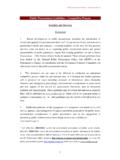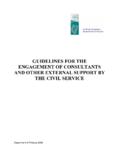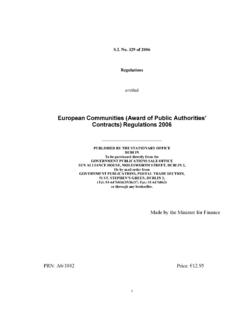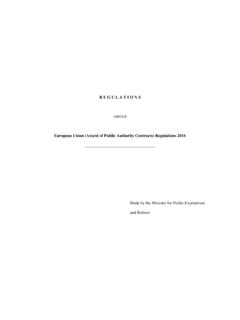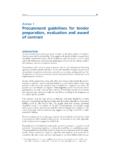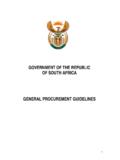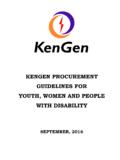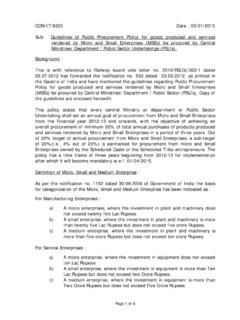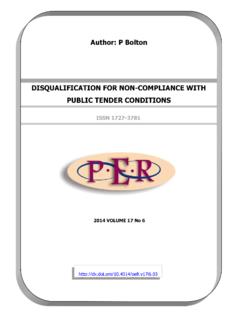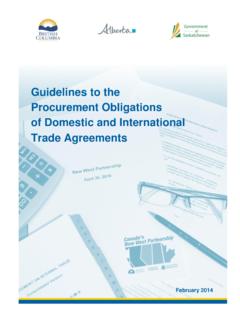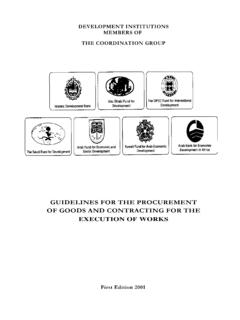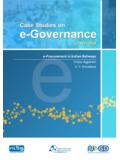Transcription of Public Procurement Checklist - eTenders
1 Public Procurement Checklist Public Procurement is the acquisition, whether under formal contract or not, of works, supplies and services by Public bodies. It ranges from the purchase of routine supplies or services to formal tendering and placing contract for large infrastructural projects by a wide and diverse range of contracting authorities. This document is designed to provide a basic Checklist covering the steps in a normal Procurement cycle, from identifying and specifying a need to awarding a contract. While the specifics of each Procurement will be different, this Checklist aims to provide a general reminder list to those required to undertake a Procurement process. Care should be taken to ensure the tender documentation is complete, relevant and proportionate to the need. Small and medium sized enterprises frequently report that they find Public sector tendering documentation complex and difficult to follow. In many cases, this arises from lengthy and detailed standard type provisions for larger contracts being cut and pasted into documentation for smaller requirements.
2 This Checklist should be read in conjunction with the national Public Procurement guidelines, Public Procurement Guidelines - Competitive Process, which provide more detailed guidance on the competitive process to be followed in the award of contracts for supplies and services. These and other guidelines are published on the national Public Procurement website (under Guides / General Procurement Guidance). This Checklist addresses the following steps in the Procurement process: 1. Identifying the need is the purchase necessary? 2. Writing the specification 3. Estimating cost 4. Securing approvals and funding 5. Determining the best Procurement strategy 6. Deciding on the tendering procedure that should be followed 7. Preparing your Request for Tender (RFT) 8. Allowing sufficient time for submission of tenders 9. Issuing tender documents, supporting documents and clarifications without delay 10. Receipting and opening tenders 11.
3 Clarifying tenders 12. Evaluation of tenders 13. Notifying tenderers 14. Debriefing unsuccessful tenderers 15. Checking tax clearance certificates 16. Awarding the contract 17. Publishing contract award notice 18. Managing the contract 1. Identifying the need is the purchase necessary? Before starting any Procurement process, it is important to establish whether it is essential to purchase. Establish whether there is a clear business need for the product or service. The Procurement should be essential for the conduct of normal business or to improve performance. Stating that the need for the Procurement is a good idea is not a sufficient business case. Ensure that the business case addresses future phases of the service or purchase of goods that may be required. Determine whether the products or services are already readily available within your organisation. 2. Writing the specification Once the need for, and what is needed from, a supplier or service provider has been established, the specification of requirements needs to be developed.
4 Base the specifications on the needs identified in the business case. Ensure that the specifications are clear and comprehensive but not discriminatory (use generic technical specification and avoid proprietary brand names). Ensure that the specifications present the optimum combination of whole-life-costs and/or price, where appropriate, and quality (or fitness for purpose) to meet your requirements. 3. Estimating cost A realistic estimate of all phases of the service or product is essential as this will influence the Procurement procedure to be followed and is important for budgeting purposes. Prepare a realistic estimate of all phases of the service or product. Establish whether funds are available to meet the purchase? Determine whether the estimate (exclusive of VAT) is over the relevant EU Procurement threshold (see Appendix I) 4. Securing approvals and funding Once a realistic estimate of cost is available the relevant budget holder should be requested to approve the expenditure.
5 Ensure that all necessary approvals are sought in adequate time. 5. Determining the best Procurement strategy Adopt a Procurement strategy that will minimise casual or once-off purchases and promote best value. Check if your organisation already has a draw-down contract or framework agreement in place for the product/service. If such an arrangement does exist but is not being used on this occasion, document the reasons why. 6. Deciding on the tendering procedure that should be followed Following an appropriate competitive tendering procedure will avoid breaches of national Procurement policy and EU Procurement Directives. The type of competitive process to be followed can vary depending on the size and characteristics of the contract to be awarded and the nature of your organisation. There are two general types of procedure which may be used: an open procedure, where all interested parties are invited to tender and a restricted (or selective) procedure where only those deemed to have the necessary capacity and expertise are invited to tender.
6 (Sections 5 and of Public Procurement Guidelines Competitive Process should be consulted for details of how these procedures apply under national and EU rules). Conduct an appropriate competitive tendering procedure. For contracts below the relevant EU Procurement thresholds, follow the steps set out in Appendix II. For contracts above the relevant EU Procurement thresholds, follow the steps set out in Appendix III. 7. Preparing your Request for Tender (RFT) A sample RFT can be viewed on A set of tips for preparing your RFT, together with a list of the sections normally included in a RFT, are provided in Appendix IV: Ensure that the RFT is clear and comprehensive. Clarity and completeness at this stage will help eliminate the need for clarifications later. Set out all the criteria that will be applied in the award process, together with the relative weightings of each. This is a vital part of the process.
7 These criteria will form the basis against which tenders will be comparatively evaluated and are the key to an objective, transparent award procedure. Specify any special conditions of tender, FOI clause, required format of tender responses etc. 8. Allowing sufficient time for submission of tenders Allow suppliers an adequate period for the preparation of tenders. Take account of the complexity of the contract when fixing the timescale for submitting responses. Allow suppliers sufficient time for submitting the necessary information and preparing the tenders (taking into account holiday periods etc). In the case of contracts in excess of EU Directive thresholds, ensure that the timescale complies with the minimum periods specified in the Directives. 9. Issuing tender documents, supporting documents and clarifications without delay Responses to requests for information, requests for tender documents and other supporting documentation (if not made available electronically on the eTenders website) must be issued without delay.
8 Issue tender documents and responses to requests for additional information in good time Ensure that additional information supplied to one party, in response to a request, is supplied to all interested parties if it could be significant in the context of preparing a tender. 10. Receipting and opening tenders You should ensure that proper procedures are in place for opening tenders. Return late tenders unopened to the tenderer and record their existence and time of arrival. Open all tenders (received on time) together as soon as possible after the designated latest time and date set for receipt of tenders. Arrange for the opening of tenders to take place in the presence of at least two officials of the contracting authority. Ensure that a clear and formal independently vouched report of the tenders received is produced. 11. Clarifying tenders You may seek additional information in clarifying submitted tenders. Ensure that any clarification of tenders does not result in substantive alterations to bids after the deadline for submission has passed.
9 12. Evaluating tenders The evaluation and award process must be demonstrably objective and transparent and based solely on the criteria published in the RFT. This is best achieved by the use of a scoring system based on all the relevant weighted criteria, indicating a comparative assessment of tenders under each criterion. Arrange for the evaluation of tenders to be carried out by a suitably competent team. Evaluate price exclusive of VAT. If price is the sole criterion, award the contract to the lowest priced bid complying with the specified requirements. If the most economically advantageous tender is the basis for award, award the contract to the tender that best meets the relevant published criteria. 13. Notifying tenderers Unsuccessful candidates and tenderers for any Public contract should be informed of the results of the tendering process without delay. In the case of contracts covered by the EU Directives, allow a 14 calendar day interval (or seven calendar days in the case of a contract advertised under an accelerated procedure due to urgency) between notifying unsuccessful tenderers of the outcome of the tendering procedure and the formal award of contract.
10 14. Debriefing unsuccessful tenderers Apart from observing the legal obligations where the provisions of the Procurement Directives apply, where contracts are awarded on the basis of the most economically advantageous it is good practice to adopt a voluntary constructive policy on de-briefing unsuccessful candidates. Offer unsuccessful tenderers debriefing. In the debriefing, provide an objective assessment of the comparative strengths and weaknesses of the unsuccessful tender. Give due regard to commercial sensitivity and the need to avoid compromising the rights or competitive situation of other tenderers. 15. Checking tax clearance certificates Before a contract is placed the supplier or service provider must hold a current Tax Clearance Certificate. This can be verified online using What can I do online , Tax Clearance . Prior permission of the applicant must be sought, and the Customer number and tax clearance certificate number quoted.

